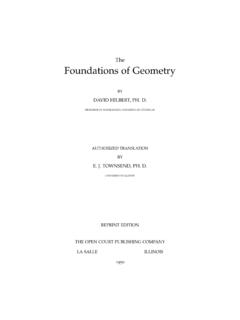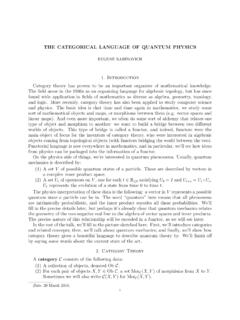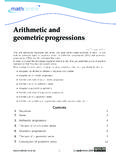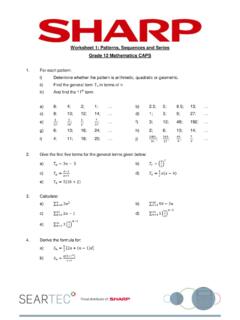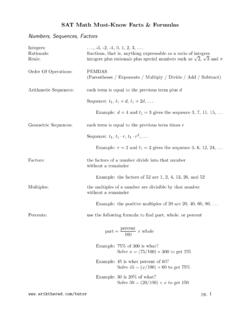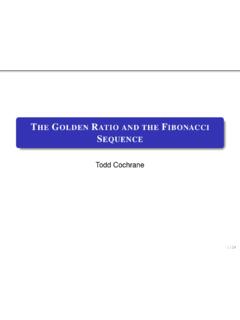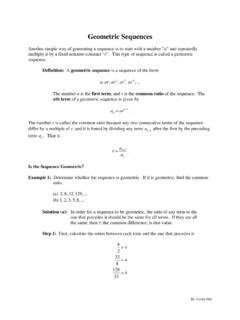Transcription of The Weierstrass Function - University of California, Berkeley
1 The Weierstrass FunctionBrent NelsonWe let sin,cos :R Rbe defined in the usual geometric way, extended to all ofR. We will assume thefollowing facts about these functions:(a) sin and cos are continuous onR;(b)|sin(x)|,|cos(x)| 1 for allx R;(c) sin(x)x 1 for allx R\{0};(d) cos(x) cos(y) = 2 sin(x+y2)sin(x y2)for allx,y R;(e) cos(x+y) = cos(x) cos(y) sin(x) sin(y) for allx,y can be derived by considering, for example, the power series representations:sin(x) = n=0( 1)n(2n+ 1)!x2n+1andcos(x) = n=0( 1)n(2n)! main goal of these notes is to prove the following theorem:Theorem(Karl Weierstrass , 1872).Leta (0,1)and letbbe an odd integer such thatab >1 +3 2.
2 Then theseriesf(x) = n=0ancos(bn x)converges uniformly onRand defines a continuous but nowhere differentiable Function appearing in the above theorem is called the Weierstrass Function . Before we prove the theorem,we require the following lemma:Lemma(The Weierstrass M-test).Let(E,d)be a metric space, and for eachn Nletfn:E Rbe afunction. Suppose that for eachn N, there existsMn>0such that|f(x)| Mn x the series n=1 Mnconverges, then the series n=1fnconverges uniformly >0. The Cauchy criterion for the convergence of a series implies there existsN Nsuch that foralln,m Nwithn < mwe have|Mn+1+Mn+2+ +Mm|=Mn+1+Mn+2+ +Mm< .Consequently, for alln,m Nwithn < mwe have for allx E m i=1fi(x) n i=1fi(x) =|fn+1(x) + +fm(x)| |fn+1(x)|+ +|fm(x)| Mn+1+ +Mm<.
3 That is, the sequence of partial sums ( ni=1fi)n Nsatisfies the Cauchy criterion for functions. So by a propo-sition from lecture we know that these partial sums converge uniformly to the series n= Weierstrass FunctionMath 104 Proof of |ancos(bn x)| anfor allx Rand n=0anconverges, the series converges uni-formly by the Weierstrass M-test. Moreover, since the partial sums are continuous (as finite sums of continuousfunctions), their uniform limitfis also see thatfis nowhere differentiable, we will show for eachx0 Rthatlimx x0f(x) f(x0)x x0does not exist. In particular, we ll show that asxapproachesx0from above and below, the respective differencequotients oscillate wildly between larger and larger positive and negative R.
4 For eachm N, let m Zbe such thatbmx0 m ( 12,12].Definexm:=bmx0 mym:= m 1bmzm:= m+ thatym x0= 1 +xmbm<0<1 xmbm=zm < x0< zm,limm |ym x0|= limm x0 ym= limm 1 +xmbm= 0,andlimm |zm x0|= limm zm x0= limm 1 xmbm= is, (ym)m Nand (zm)m Nare (meticulously constructed) sequences converging tox0, but from above andbelowx0, respectively. We will examine the difference quotients forfproceeding alongx=ym,m N, andx=zm,m N. First,f(ym) f(x0)ym x0= n=0ancos(bn ym) n=0ancos(bn x0)ym x0= n=0ancos(bn ym) cos(bn x0)ym x0=m 1 n=0(ab)ncos(bn ym) cos(bn x0)bn(ym x0)+ n=0an+mcos(bn+m ym) cos(bn+m x0)ym denote the two sums in the last expression byS1andS2, respectively.)
5 Roughly speaking, we will show thatS1is small whileS2is big. Using property (d), we haveS1=m 1 n=0(ab)n 2bn(ym x0)sin(bn (ym+x0)2)sin(bn (ym x0)2)=m 1 n=0 (ab)nsin(bn (ym+x0)2)sin(bn (ym x0)2) bn(ym x0) the triangle inequality and properties (b) and (c) we have|S1| m 1 n=0 (ab)n1 1 = (ab)m 1ab 1< (ab)mab , there exists 1 ( 1,1) such thatS1= 1 (ab)mab Brent Nelson 2017 The Weierstrass FunctionMath 104 Next, we handleS2. First, recall thatym= m 1bm, that mis an integer, and thatbis an odd integer. Thuscos(bn+m ym)= cos (bn ( m 1)) = ( 1)bn( m 1)= ( 1) m 1= ( 1) , recall thatxm=bmx0 mso that using property (e) we havecos(bn+m x0)= cos (bn (xm+ m))= cos(bn xm) cos(bn m) sin(bn xm) sin(bn m)= ( 1)bn mcos(bn xm) 0= ( 1) mcos(bn xm).
6 Using these computations, we haveS2= n=0an+m ( 1) m ( 1) mcos(bn xm)ym x0= n=0an+m( 1)( 1) m1 + cos(bn xm) 1+xmbm= (ab)m( 1) m n=0an1 + cos(bn xm)1 + thatxm ( 12,12]so the terms in the sum in the last expression are non-negative. Consequently, n=0an1 + cos(bn xm)1 +xm 1 + cos( xm)1 +xm 11 +12= there exists 1 1 such thatS2= (ab)m( 1) m our computations forS1andS2together yieldsf(ym) f(x0)ym x0=S1+S2= 1 (ab)mab 1+ (ab)m( 1) m 123= ( 1) m(ab)m 1(23+ ( 1) m 1 1 ab 1)Recall our assumption thatab >1 +3 2, which is equivalent to ab 1<23. Using| 1|<1 and 1, we have23+ ( 1) m 1 1 ab 1>23 ab 1> , the sign off(ym) f(x0)ym x0is completely determined by ( 1) mand f(ym) f(x0)ym x0 >(ab)m(23 ab 1)Thus, not only does the difference quotient alternate signs rapidly, but its magnitude tends to + asm.)
7 Since limm ym=x0, this is enough to show that limx x0f(ym) f(x0)ym x0does not exist. We will show somethingslightly stronger: the same behavior also occurs along (zm)m the same breakdown as before, we can writef(zm) f(x0)zm x0=S 1+S 2,and the same argument yieldsS 1= 2 (ab)mab 1for some 2 ( 1,1). Usingzm x0=1 xmbmwe haveS 2= n=0an+m ( 1) m ( 1) mcos(bn xm)1 xmbm= (ab)m( 1) m n=0an1 + cos(bn xm)1 Brent Nelson 2017 The Weierstrass FunctionMath 104 Sincexm ( 12,12], the terms in the sum in the last expression are non-negative. Consequently, n=0an1 + cos(bn xm)1 xm 1 + cos( xm)1 xm>11 ( 12)= there exists 2 1 such thatS 2= (ab)m( 1) m 223.)
8 Thenf(zm) f(x0)zm x0=S 1+S 2= 2 (ab)mab 1 ( 1) m(ab)m 223= ( 1) m(ab)m 2(23 ( 1) m 2 2 ab 1).Just as before we have23 ( 1) m 2 2 ab 1>23 ab 1>0,so that the sign off(zm) f(x0)zm x0has sign completely determined by ( 1) m. Also, f(zm) f(x0)zm x0 >(ab)m(23 ab 1)m + So the same behavior occurs to the right ofx0. The graph of the Weierstrass Function The rough shape of the graph is determined by then= 0 term in the series: cos( x). The higher-order termscreate the smaller oscillations. Withbcarefully chosen as in the theorem, the graph becomes so jagged thatthere is no reasonable choice for a tangent line at any point; that is, the Function is nowhere Brent Nelson 2017
